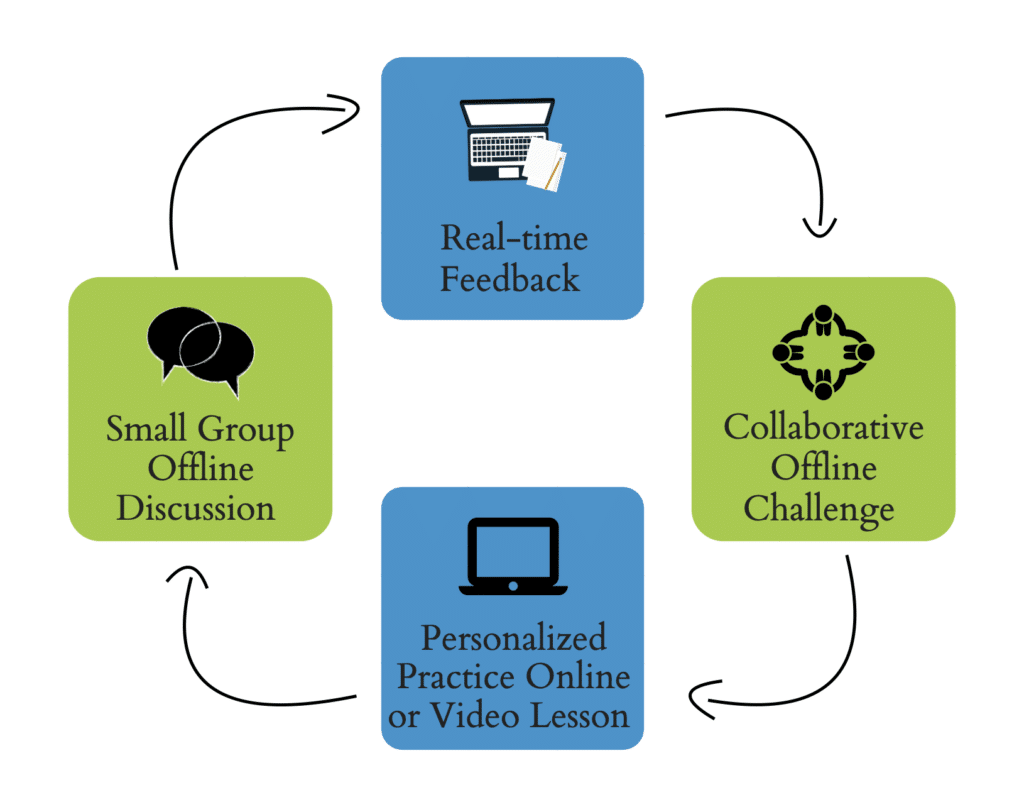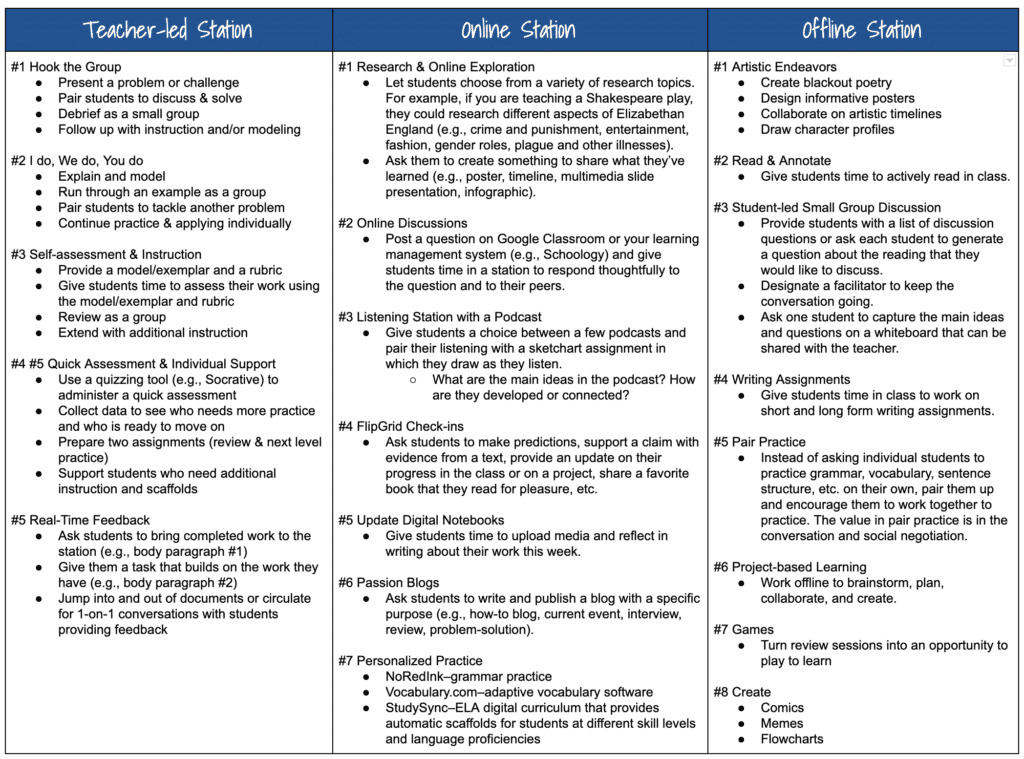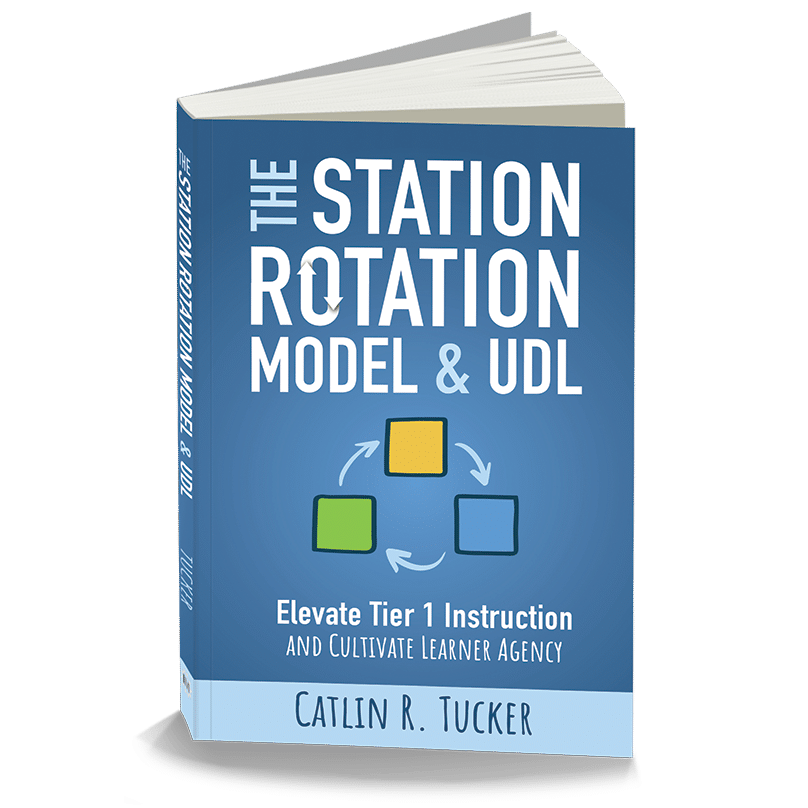“What are students doing in the stations that are not the teacher-led station?” I field a lot of questions like this. Teachers want to know what types of activities I incorporate into station rotation lessons.

Since my teaching experience is in English, I wanted to share some of my favorite station ideas to inspire teachers who are flirting with the idea of trying the station rotation model. For those teachers who are already using the station rotation model, I hope you can add these ideas to your rotations to keep kids interested and engaged.

The goal of any station rotation design should be to balance the various elements in the lesson.
- Online vs. offline
- Individual tasks vs. collaborative tasks
- Teacher talk vs. student talk
- Teacher direction vs. student agency
- Teacher feedback vs. peer feedback
- Teacher assessment vs. self-assessment
Too often I see stations that do not balance these elements, and students are left to work in isolation. The more teachers build student choice and voice into their station design, the more likely students are to engage in the tasks at the various stations.
If you have favorite station activities and tasks you use in your English classroom, please post a comment and share them here!
The Station Rotation Model and UDL: Elevate Tier I Instruction and Cultivate Learner Agency is available now! I’d love for you to check it out, share it with a colleague, and let me know what resonates most with you. If you have any questions about the book, please post a comment!
School leaders interested in using the book for a staff-wide study can place a discounted bulk order for 10 or more copies. If you and your teachers need additional support, I offer customized professional learning that is hands-on, practice-based, and tailored to your team’s needs. Together, we can support your teachers in developing their UDL practice, differentiating instruction more effectively, and elevating Tier 1 instruction. We can even utilize the Station Rotation Model to create space for Tier 2 support and Tier 3 intervention within general education classrooms. And, we can explore how this model can help us position students as active agents leading their learning!


19 Responses
Hi. Have a few questions you might be able to shine light on with your insight. Specifically around offline stations and the ‘need’ for them as balance.
Can you tell me the differences in your Blended Learning books? I would like my school to purchase one for me but they will only get one book. Which book would be most applicable for 5th and 6th grader English classes?
Hi Theresa,
Blended Learning in Action is good if you are just getting started with blended learning and want to explore the various models and explore issues related to transitioning to blended learning from traditional instruction (e.g., onboarding students to technology and designing lessons). If you want a book that is entirely English focused, I would recommend Creatively Teach the Common Core Literacy Standards with Technology even if you are not in a state that adopted or modified the Common Core. It is organized into reading, writing, language/grammar, and speaking and listening with ideas for using technology to develop those various skills. If you are already using blended learning models and want to move to the next level to integrate metacognitive skill building and use the models to move feedback and assessment into the classroom then I would suggest pre-ordering Balance with Blended Learning coming out in late January.
Catlin
[…] Planning a Station Rotation for Your English Classroom | […]
Do you have a suggestion on activities for younger elementary school age students? It is somewhat impossible if their writing or computer skills are not there yet.
Hi Patti,
I posted a blog a couple of weeks ago that may be helpful.
https://catlintucker.com/2020/08/engage-elementary-students-online
Catlin
Research&online exploration is the better.
good day. Ms Tucker may I ask for a sample lesson plan of English Grade 4 showing Station Rotation Model? I am currently conducting research on this model. I hope you will share your pieces to me. Thank you so much.
Hi Jane,
I do not know that I have access to a 4th-grade example. I can look through my coaching files, but I don’t have them labeled by the teachers’ grade levels. Did you have a specific question about how to approach the design?
Catlin
Hi Catlin,
Does the station rotation model work for a 70-minute lesson? How much time should students typically spend at each station for learning to be meaningful? I imagine it would be quite challenging to rotate students among 4 stations, including a teacher-led station if I only have 70-mins to run this lesson. Can the use of this model span across a few lessons?
Absolutely, Shyuan. I’m coaching a group of teachers right now who have 65 minute periods. They have broken their class into three groups and they rotate through three stations for 20 minutes each.
Catlin
I was wondering how to effectively use station rotations for a 53 minute 7th grade English class, where I incorporate reading and writing each day, using a workshop method? Thank you!
Hi Kathee,
You could do one of two things. Option 1: You could design a “flip-flop,” or rotate students through two learning experiences (e.g., a teacher-led station and self-directed or collaborative station). That way, you would have half the class at a time for your mini-lesson or feedback sessions at the teacher-led station to more effectively differentiate that experience. Option 2: Run a multi-day rotation. For example, you could design a 4 station, two-day rotation in which students hit two stations each day. Students do not have to complete the entire rotation in a single day.
I hope that provides some ideas for how to make this work given the length of your class period and your use of the workshop model.
Take care.
Catlin
As a college student, I found this article super useful! Thanks for posting and sharing these tips, Catlin!
I am anxious to try these station rotations in my intervention reading groups.
Do you have a rubric or suggestion to design a rubric that can be posted at each station to ensure that students are on task and know how they are being graded?
Hi Tiffani,
I would not attempt to grade everything students do at each station as that will not be sustainable long-term. You can create a one-skill rubric and ask students to self-assess their work or participation in a station, but I would be selective about what you spend your time grading. Below is a link to a blog I wrote about deciding what to grade and spend your finite time and energy on.
https://catlintucker.com/2019/02/ask-yourself-why-am-i-grading-this/
Take care.
Catlin
We teach English Language, Maths and Science in village communities where internet connections and computers are not an option. would you please give us a pen / pencil and paper model for English Language teaching. Children are from poor socioeconomical background.
Hello Emmanuel,
Thank you for reaching out and for the incredible work you are doing to educate children. While the station rotation model is often associated with blended learning and technology, its core purpose is to engage students in smaller, more focused learning experiences where they have more control over the pace of their learning and allow the teacher to provide differentiated instruction for small groups. This can absolutely be adapted to work without computers or internet access.
Even without digital tools, you can create three to four offline stations where students rotate through different language-rich activities that develop their reading, writing, speaking, and listening skills. Here’s how you might structure it:
1. Teacher-Led Station: Guided Reading and Speaking Practice
Work with a small group of students on a short reading passage (a story, poem, or dialogue). Focus on pronunciation, vocabulary, and comprehension by asking students to read aloud, discuss meanings, and use new words in sentences. You can model correct grammar and sentence structure, helping students practice conversation skills in a supportive setting.
2. Peer-to-Peer Station: Partner or Group Speaking & Writing Activity
Students pair up or form small groups to complete a language task together (e.g., creating a short dialogue, acting out a scenario, or answering discussion questions). One engaging option is story-building—one student starts a sentence, and each student adds on to build a collaborative story. If writing materials are limited, they can verbally construct their ideas and then share with the class.
3. Independent Station: Writing or Vocabulary Practice
Students work individually on tasks like sentence-building, fill-in-the-blank exercises, or journaling about a given topic. You can provide picture-word matching activities or word puzzles to help with vocabulary retention. If resources allow, students can maintain a personal word journal where they write new words, draw pictures, or use the word in a sentence.
I hope this framework helps you maximize your resources while making language learning engaging and effective for your students. Please feel free to reach out if you’d like more specific examples or adjustments for your unique setting!
Best,
Catlin